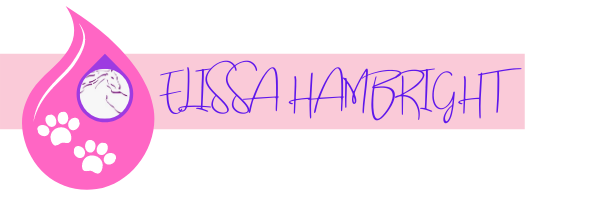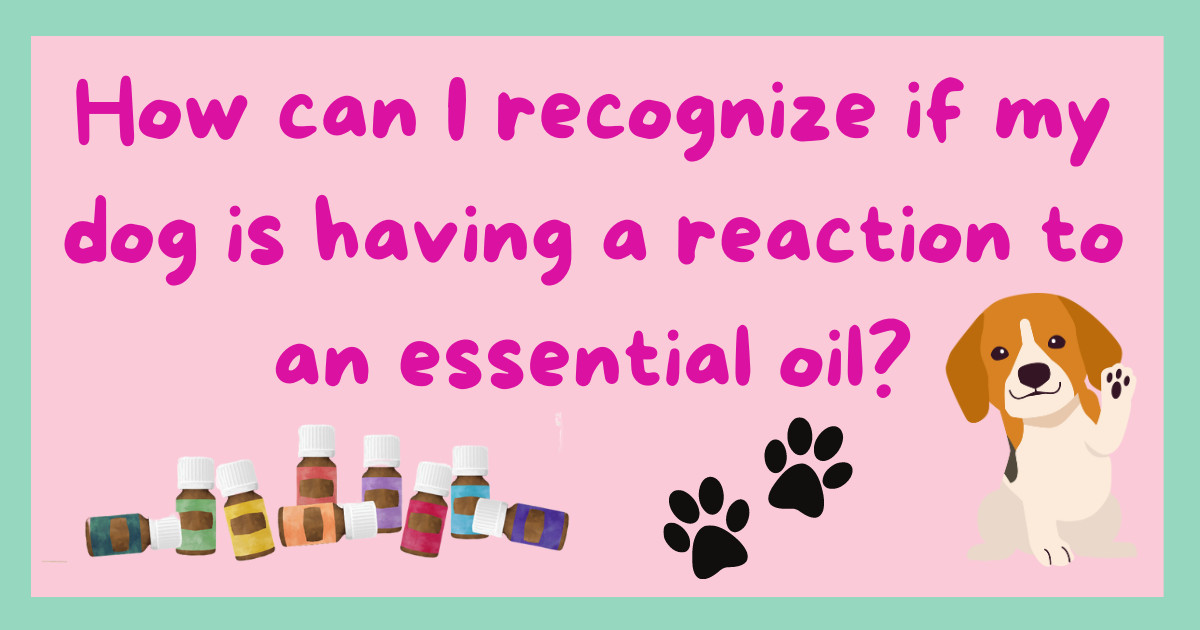
Hey there, fellow dog moms and wellness enthusiasts! So, today I've had a very good question come in from a gal who's just started diffusing essential oils and noticed her dog started to cough. She was wondering if it could be related, and that's a great question! So, this week's blog is dedicated to what to look for when using essential oils with your dog to make sure it's all going okay.
This discussion is not meant to deter essential oil use in dogs; in fact, I've been incorporating essential oils into my own dogs' wellness routines for over 8 years now. Take BB, for example, my infamous 5-pound Chihuahua – he's been benefiting from essential oils alongside me every step of the way. Essential oils are undeniably a valuable tool in the wellness toolbox for our furry companions.
When using premium and pure unadulterated essential oils properly, the likelihood of adverse reactions in dogs is significantly reduced. In fact, when sourced from reputable suppliers and applied with care, these high-quality oils can offer a myriad of benefits to our furry companions. Essential oils have been celebrated for their natural wellness properties for centuries, and when used responsibly, they can be a valuable tool in supporting our dogs' overall well-being. From soothing skin and supporting healthy fur, to promoting relaxation and emotional balance, the wellness potential of essential oils is vast.
However, it's crucial to recognize that every dog is unique, and not all essential oils are created equal. That's why my motto when using essential oils with your dog is simple: go low, go slow, and observe. This blog is dedicated to helping you do just that – observing and understanding how essential oils can best serve your dog's health and happiness.
First off, let's talk about why essential oils might cause a reaction in dogs.
Essential oils are potent plant extracts derived from various aromatic plants and herbs. While these oils offer a plethora of wellness benefits for humans and animals alike, it's essential to recognize that dogs, like humans, can have individual sensitivities and physiological differences that may influence their response to these concentrated compounds.
One primary reason why essential oils might cause a reaction in dogs is their unique physiology. Dogs have a highly sensitive sense of smell and a different metabolic rate compared to humans. Their bodies metabolize substances at varying rates, and what may be safe for us could potentially overwhelm their systems.
Additionally, certain chemical components present in essential oils could have the potential to trigger reactions in sensitive individuals. Common constituents found in many essential oils may cause different responses in some dogs.
Moreover, the method of application plays a significant role in how dogs interact with essential oils. Inhalation, topical application, and ingestion are the primary routes of exposure. All three methods can be safe and benefit your dog. To read more about the three methods of application, click HERE.
If you are just starting out, inhalation is the easiest and safest method. Diffusing essential oils with a diffuser is a fabulous way for you and your dog to enjoy the benefits of essential oils. Using a water based ultrasonic diffuser dilutes the essential oil. Click HERE for my in depth blog about diffusing essential oils with your dog.
Topical application is another great way to use essential oils with dogs. Diluting the essential oil with a carrier oil like fractionated coconut oil minimizes any chance of a skin reaction. Click HERE to read more about carrier oils for topical use. If applied undiluted or in high concentrations, you could see skin irritation or sensitization. If this occurs, simply add more carrier oil, this will further dilute the essential oils and slow the absorption rate to a level your dog can tolerate.
Ingesting essential oils can provide additional benefits, but it's important to exercise mindfulness when considering this practice. Ensure the quality and suitability of the essential oil, understand your reasons for internal use, and consider your dog's health and condition. Only use essential oils labeled for ingestion, and always read your labels carefully. Working with a holistic veterinarian trained in essential oil use can provide valuable guidance and support for this method.
Interestingly, many dog foods on the market today contain essential oils as natural preservatives, meaning your dog may already be ingesting them to some extent. While ingestion remains a somewhat controversial topic in the essential oils world, it's essential to understand that you can experience the benefits of essential oils through various methods. If you're uncomfortable with ingesting oils, simply opt for alternative methods. Remember, the skin is our largest organ, and what we apply topically gets absorbed into the body. Likewise, inhaling essential oils allows absorption through the lungs. While ingestion can be a valuable tool, it's not a requirement for reaping the benefits of essential oils.
It's also essential to consider the quality and purity of the essential oils being used. Low-quality oils may contain contaminants or adulterants that can exacerbate adverse reactions in dogs. Opting for high-quality, premium-grade oils from reputable sources can minimize the risk of adverse effects.
Now, you might be wondering, how can I tell if my dog is having a reaction to an essential oil? Here are some signs to watch out for:
- Skin Irritation: Keep an eye out for redness, itching, or irritation on your dog's skin after applying or diffusing essential oils. This could manifest as rashes, hives, or hot spots. Pay close attention to areas where the oil was applied.
- Excessive Scratching or Licking: If your dog starts scratching or licking themselves more than usual, it could indicate a reaction. Persistent scratching, especially around the ears, face, or paws, may signal discomfort or irritation.
- Respiratory Issues: Watch for abnormal breathing signs, such as coughing, wheezing, sneezing, or even heavy breathing. Dogs with sensitive respiratory systems may be overwhelmed with airborne essential oil particles, particularly in poorly ventilated spaces.
- Digestive Upset: Keep an eye on your pup's digestive health. Symptoms like vomiting, diarrhea, or excessive drooling could indicate that their stomach isn't tolerating certain essential oils well.
- Behavioral Changes: Pay attention to any unusual behavior exhibited by your dog after exposure to essential oils. This could include lethargy, restlessness, agitation, stupor, or changes in appetite. Dogs may show signs of discomfort or distress through their behavior.
- Swelling or Inflammation: Be vigilant for any swelling or inflammation, particularly around the face, muzzle, or eyes. These are common areas where reactions may manifest.
Alright, now that we've covered the signs of an adverse reaction, let's talk about what to do if you suspect your dog is experiencing one:
- Stop Use Immediately: If you suspect your dog is reacting to essential oils, stop using the essential oil. If you were diffusing the oil, ensure proper ventilation and remove your dog from the area.
- Dilute Further: If the oil was applied topically, further dilute it with additional carrier oil to lessen its potency and slow down absorption, making it better tolerated by the body. Since essential oils do not mix with water, attempting to rinse the oil off can actually drive it further into the skin. Instead, remember that essential oils are lipid-loving (attracted to fat), so adding more carrier oil will effectively bind with the essential oil.
- Evaluate: Delve into the specific essential oil you used and its application method. Often, reactions stem from issues related to quality or excessive usage. If symptoms persist despite discontinuing oil use and additional dilution, consult a veterinarian promptly. Your vet can offer expert guidance, recommend appropriate treatments, and provide supportive care to alleviate your dog's symptoms effectively.
- Monitor Your Dog: Keep a close eye on your dog and monitor their condition closely. Note any changes in their symptoms and behavior, and be prepared to provide updates to your vet if necessary.
- Prevention is Key: Moving forward, take a look at the essential oil you were using, the quality, and how you were using it. You might have just used too much, you might have used an inferior oil with contaminants, or your dog may truly be sensitive to that essential oil. There are over 300 plants that are distilled for essential oils on the market and many have similar benefits, so moving forward consider consulting with a holistic veterinarian trained in the use of essential oils or canine aromatherapist for guidance to use the right essential oil for your dog.
When encountering issues with essential oils, it's crucial to recognize that the root cause is often linked to the quality of the oil and how it was used. High-quality, pure essential oils sourced from reputable suppliers undergo rigorous testing and adhere to strict quality standards, ensuring that they are free from contaminants, adulterants, and harmful chemicals. However, lower-quality oils and those that have been improperly used pose a greater risk of adverse reactions in dogs.
Additionally, the method of application plays a significant role in determining the outcome. Diluting oils appropriately, using them in well-ventilated spaces, and respecting each dog's individual sensitivities are essential practices to minimize the likelihood of problems. By prioritizing the use of premium oils and employing proper techniques, we can provide our furry friends with the safest and most beneficial experience when incorporating essential oils into their wellness regimen.
Ready to take your knowledge of essential oils and your dog's well-being to the next level? Join me in my Oily Dog Intro course, where we'll take a deep dive into safely using essential oils with your furry companion. Whether you're new to essential oils or looking to expand your expertise, this course is designed to empower you with the knowledge and confidence to support your dog's health naturally. Don't miss out – sign up today and embark on a journey to holistic wellness for you and your canine companion! Click HERE!
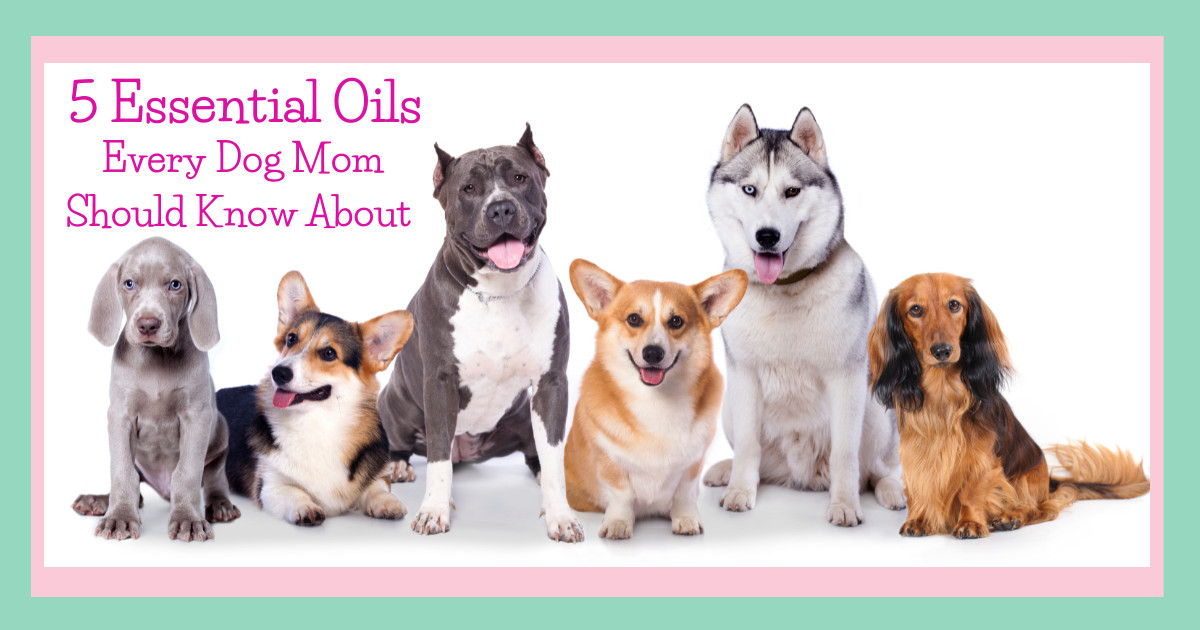
As a devoted dog mom and an advocate for the wonders of natural remedies, I've heard countless times from fellow pet parents: "With so many essential oils out there, which ones are safe for our furry companions, and where on earth do I begin?" It's a question that's as common as tail wags at treat time.
The world of essential oils can indeed be a bit overwhelming, but worry not, because we're about to embark on a journey to demystify it all. In this blog, I'll not only introduce you to the top 5 essential oils I think every dog mom should know about but also shed light on their safety and practical uses. So, let's dig our paws into the earthy goodness of nature's remedies and set you on the path to creating a healthier, happier life for you and your four-legged family member.
What Are Essential Oils?
First things first, let's get the basics down. Essential oils are concentrated, aromatic compounds extracted from plants. They're like nature's potent gifts, packed with wellness properties. These oils come from various parts of plants, like leaves, stems, flowers, and more.
Essential oils are like the lifeblood of plants, containing a fascinating array of compounds that serve multiple purposes for the plant's survival and well-being.
Within the intricate chemistry of essential oils, you'll discover a symphony of aromatic molecules, including terpenes, phenols, aldehydes, and more. These compounds not only give each essential oil its unique fragrance but also carry out vital roles for the plant.
For the plant, essential oils serve as natural protectors. They can deter pests, fungi, and other potential threats, acting as a plant's defense mechanism. Additionally, essential oils play a role in attracting pollinators, as the enticing scents lure bees, butterflies, and other critters to aid in the plant's reproduction.
Essential oils also support the plant's overall health by assisting in wound healing and regeneration. They help repair damaged tissues and can have antimicrobial properties to prevent infections.
In essence, these remarkable oils are the plant's guardians, healers, and communicators, and when we harness their power, they can become our allies in promoting wellness for ourselves and our furry companions.
Safety is paramount when it comes to using essential oils with our beloved pets. Two of the most critical safety factors to consider are the quality of the essential oils and proper dilution.
Quality
Ensuring that you're using high-quality, pure essential oils is non-negotiable. Opt for oils that are 100% natural and free from additives or synthetic components. Cheap, low-quality oils may contain harmful substances that can be toxic to your pets. Look for reputable brands that provide detailed information about their sourcing, testing, and purity. While high-quality oils may come with a higher price tag, investing in pure essential oils is paramount for safety. Remember, low-quality oils often fall short in both efficacy and safety.
Dilution
Essential oils are potent, it can take around 75 lemons to make one 15 ml bottle of lemon essential oil. Proper dilution helps prevent adverse reactions. In general, it's best to always dilute essential oils before using them with your pets.
By prioritizing the quality of your essential oils and diluting them appropriately, you'll provide a safe and nurturing environment for your furry companions to benefit from the incredible properties of these natural remedies.
Now, let's meet our fabulous five essential oils:
1. Lavender Oil 💜Known for its calming and soothing properties, lavender is your go-to oil for helping your furry friend relax. It's also great for soothing minor skin irritations. Lavender oil is so versatile that it's also known the "Swiss army knife of essential oils" for its multi-faceted nature. This remarkable oil, derived from the lavender flower, boasts a wide range of wellness properties that make it a must-have in any essential oil collection. Lavender is my go-to for relaxation, calmness, and supporting skin and coat health.
2. Frankincense Oil 🌟Frankincense essential oil, derived from the resin of Boswellia trees, is truly a gift from nature. Its history is rich and storied, with references dating back thousands of years, including its use in ancient rituals and religious ceremonies.
One of the standout qualities of frankincense is its ability to promote overall wellness. Often referred to as the "king of oils," it's known for its profound impact on emotional and mental well-being. Frankincense has a calming and grounding aroma that helps reduce tension and balance the emotions, making it an excellent choice for moments when you need a sense of inner peace.
In addition to its emotional benefits, frankincense is also a skincare superstar. Its properties make it an excellent choice for promoting healthy skin. Moreover, frankincense has a unique ability to support cellular health and immune function. If you're seeking emotional balance, relief from physical discomfort, or radiant skin, frankincense is a must have.
3. Copaiba Oil 🌿Copaiba is a powerhouse for relief from discomfort. It's tapped from the resin of South American Copaifera trees. This oil contains high levels of beta-caryophyllene, a compound that has been studied for its anti-inflammatory and analgesic effects. This makes copaiba an excellent choice for those dealing with discomfort. It's also has a mild, earthy aroma that even sensitive dogs seem to tolerate well and can promote relaxation and emotional balance.
4. Peppermint Oil 🌱Peppermint oil is a breath of fresh air. It can help support digestion and the musculoskeletal system. One of peppermint oil's most celebrated qualities is its ability to support digestive health. Its natural menthol content can also soothe discomfort, making it the perfect addition for a muscle and joint rub. Peppermint oil is also an excellent choice for mental clarity and alertness. When diffused, it can boost concentration and productivity, making it a valuable companion during training sessions. Additionally, peppermint oil has been studied for a natural insect repellent. Results are positive as a deterrent for unwanted pests, making it a great choice for outdoor activities and as an addition to a bug spray.
5. Cedarwood Oil 🌲Cedarwood is like a walk in the forest. This oil comes from the wood of cedar trees. One of cedarwood's prominent attributes is its calming effect on the mind and body. Its warm, woody aroma promotes relaxation and can help ease tension. Cedarwood oil has also been studied for its ability to repel insects naturally, making it an excellent choice for those looking to avoid chemical-laden insect deterrents. Cedarwood is beneficial for skin and coat care. It has wellness properties that can aid in soothing skin. Additionally, cedarwood is often used to enhance focus and concentration, making it another go to during a training session. I always like to smell cedarwood oil and then study my dressage test!
Let's talk about an easy and gentle way to introduce essential oils to your dog's world, especially if you're just starting out on this aromatic journey.
Getting Started with Essential Oils
If you're a newbie to the world of essential oils, it's a great idea to begin with one of the oils we've discussed, like lavender. Before diving into diffusing, consider wearing it as a perfume around your dog. Why, you ask? Well, dogs have an extraordinary sense of smell, sometimes even 10,000 to 100,000 times more sensitive than ours! So, it's important not to overwhelm them.
Wearing an essential oil as a perfume serves two wonderful purposes. First, it allows your dog to get acquainted with the aroma in a subtle and non-invasive way. Think of it as a gentle introduction. Second, it creates positive associations. For instance, if you're using lavender to reduce tension in your dog, wear it during playtime or cuddle sessions. This way, when your dog smells lavender again, they'll associate it with those joyful and calming moments.
By taking these small and considerate steps, you'll ensure that your dog's first experience with essential oils is a pleasant and positive one.
Making the leap to an ultrasonic diffuser is a fantastic next step in your essential oil journey with your dog.
Ultrasonic Diffusers
These little wonders are a game-changer when it comes to enjoying the benefits of essential oils. An ultrasonic diffuser is a device that uses ultrasonic vibrations to disperse a fine mist of essential oil and water into the air. It's like turning your favorite oils into a gentle, aromatic cloud.
Here's how it works: The diffuser has a water reservoir where you mix your chosen essential oil with water. The device then uses ultrasonic vibrations to break down this mixture into tiny particles, creating a mist that's released into the air. This mist carries the aroma and wellness properties of the oils throughout your space.
If you're curious about my personal favorite ultrasonic diffuser, you can click HERE to check it out.
For guidelines on diffusing essential oils around your dog, be sure to visit my blog HERE. Starting small is key; begin with just a couple of drops of a single oil and observe how your dog reacts. Personally, I usually use 4-6 drops in my diffuser, but the amount can vary depending on the type and size of your diffuser. If you want more details on the different diffusers available on the market, you can find them HERE.
An ultrasonic diffuser allows you to tailor the atmosphere to meet both your and your dog's needs, whether it's for relaxation, freshening the air, or infusing positivity. Here are some of my top diffuser recipes featuring the essential oils mentioned earlier.
Calm Cloud
2 drops Lavender
2 Drops copaiba
Air freshener
2 drops lavender
2 drops peppermint
Grounded and Stable
2 drops frankincense
2 drops cedawood
If you don't have an ultrasonic diffuser on hand, worry not! You can still enjoy the benefits of essential oils by making your very own aromatic spray. It's simple and effective. To guide you through the process, I invite you to grab my step-by-step guide on making your own spray HERE. Additionally, if you're curious about alternative ways to diffuse essential oils without a diffuser, don't forget to check out my blog HERE for some creative and easy-to-follow techniques.
For targeted and convenient topical application, consider making your own essential oil roll-on. It's a breeze! Simply take a 10 ml roller bottle, readily available on Amazon, and add around 10 drops of your chosen essential oil. I personally love using fractionated coconut oil as my carrier oil – it's light, non-greasy, and budget-friendly. Fill the rest of the bottle with this carrier oil, giving you the perfect blend for safe and easy application. If you'd like a step-by-step guide to creating your roll-on, don't hesitate to check out my comprehensive tutorial HERE.
Your journey into the world of essential oils as a devoted dog mom is filled with endless possibilities. By understanding the basics of safe usage, introducing oils in gentle ways, and exploring various applications like diffusers, sprays, and roll-ons, you're well on your way to creating a healthier and happier environment for both you and your four-legged companions.
Now, you might be wondering where to get your essential oils. I invite you to explore Young Living™, a trusted source with their Seed to Seal™ commitment, ensuring pure and premium essential oils. I can personally vouch for their commitment to purity and excellence because I've had the incredible opportunity to visit their farms, roll up my sleeves, and help plant and harvest the very plants that become these precious oils.
Young Living's™ unique Seed to Seal™ commitment is more than just a promise; it's an open door policy that ensures transparency and trust at every step of the production process.
Please note that this is an affiliate link, which means I may earn a commission if you make a purchase through these links. As a special treat, I've put together a bundle featuring the 5 essential oils we discussed, a quality diffuser, and my favorite carrier oil HERE. It's a fantastic way to kickstart your essential oil journey with confidence and convenience. Happy oiling, fellow dog moms!

A common question I often encounter is, "What essential oils are effective for alleviating dog allergies?" Delving into this topic reveals a complex web of potential triggers, spanning environmental and food-related factors. However, before reaching for essential oils, it's crucial to address the root cause of your dog's allergies. Uncovering the specific allergens and employing natural remedies, such as essential oils, can play a supportive role in the overall process. In this discussion, we'll navigate through the intricacies of canine allergies, exploring essential oils as potential aids while emphasizing the importance of identifying and addressing the underlying causes for a comprehensive and tailored approach to your dog's well-being.
What Are Allergies?
Allergies in dogs stem from an imbalance within the immune system, where this complex defense mechanism overreacts to substances that are typically harmless. The immune system's primary role is to identify and combat potential threats to the body. However, in the case of allergies, it can misinterpret innocuous elements as harmful invaders, triggering an exaggerated response.
This hypersensitivity leads to the release of various chemicals, such as histamines, causing common allergic symptoms in dogs. Itching, redness, sneezing, and gastrointestinal issues are manifestations of the immune system's heightened reaction to substances like environmental factors or certain food ingredients. Understanding this immune system imbalance is pivotal in addressing and managing allergies in our beloved canine companions.
Common Causes of Canine Allergies:
1. Environmental Allergens:
- People commonly associate environmental factors with external elements like pollen, dust, mold spores, and blooming plants. However, it's crucial to recognize that environmental factors encompass everything your dog encounters in its surroundings. Studies indicate that indoor pollution, stemming from everyday household products, can lead to air quality issues surpassing that of the outdoors. Environmental allergens extend beyond traditional sources to include your personal care items, cleaning agents, air fresheners, and even laundry soap. Essentially, anything within your home can impact both you and your dog.
Therefore, it's essential not only to address external factors but also to scrutinize and choose toxin-free products within your home. Take a proactive approach by reading product labels, seeking and eliminating items containing artificial fragrances, preservatives, harsh cleaners, and unidentified chemical compounds. Opting for cleaner, toxin-free alternatives can contribute significantly to creating a healthier living environment for both you and your canine companion.
2. Food Allergies:
- Common ingredients such as beef, chicken, wheat, soy, corn, and dairy frequently trigger food allergies in dogs, leading to various symptoms. For a comprehensive approach to your dog's nutrition, consider consulting a holistic veterinarian with expertise in canine nutrition. They can provide valuable insights into the benefits of raw or home-cooked diets, which are considered optimal in today's context.
A holistic veterinarian is well-equipped to guide you through the nuances of crafting a nutritionally balanced raw or home-cooked diet tailored to your dog's specific needs. Additionally, they may recommend alternative protein sources, such as fish or rabbit, to mitigate allergic reactions.
By seeking advice from a holistic veterinarian, you can make informed decisions about your dog's diet, promoting their overall well-being and addressing potential food allergies effectively.
3. Parasites:
- External parasites like fleas and ticks, or internal parasites such as worms, can trigger allergic reactions in dogs. The saliva from flea bites is a common allergen, causing dogs to bite at their coat and skin, leading to redness and irritation. Intestinal parasites may contribute to gastrointestinal issues, including vomiting and diarrhea.
Genetics and Canine Allergies
Genetics can significantly influence a dog's susceptibility to allergies, as certain breeds are predisposed to specific allergic reactions. Inherited factors may contribute to an increased likelihood of developing hypersensitivity to environmental elements or certain food ingredients. Understanding the genetic component of canine allergies can help anticipate potential sensitivities and tailor preventive measures accordingly.
While not all dogs with a genetic predisposition will develop allergies, being aware of breed-specific tendencies allows for proactive care and early intervention. Collaborating with a veterinarian can aid in identifying potential genetic factors and developing a customized strategy to manage and alleviate allergy symptoms in genetically predisposed dogs.
Allergy symptoms:
Allergy symptoms in dogs can manifest in various ways:
Excessive paw licking
Persistent itching and scratching
Redness and irritation
Biting at the coat and skin
Excessive shedding
Swelling and the appearance of bumps
Respiratory symptoms like sneezing, coughing, and difficulty breathing
If you observe any of these symptoms, consult with your veterinarian for a comprehensive evaluation and appropriate treatment plan tailored to your dog's specific needs. Once the cause is determined, natural remedies, including essential oils can be incorporated to provide supportive care. Working hand-in-hand with a vet ensures that any natural interventions align with your dog's individual health needs, promoting a holistic and effective strategy for alleviating allergy symptoms and enhancing overall well-being.
General Tips for Managing Allergies:
1. Regular Grooming:
- Keep your dog's coat clean and well-groomed to reduce the accumulation of allergens. This will also help with early detection and prevention of parasites. You can also wipe your dog off after he has been outside.
DIY dog wipes infused with essential oils can help mitigate environmental factors by gently cleansing your dog's coat after outdoor activities and help keep an accumulation of potential environmental causes at bay. To make your own easy DIY dog wipes, check out my step by step blog post HERE.
- Tip: Use a hypoallergenic and natural shampoo to soothe sensitive skin. A shampoo full of toxic chemicals can contribute to allergies. For my favorite natural shampoo that utilizes the power of essential oils, click HERE.
2. Clean Living Spaces:
- Regularly clean and vacuum your home to minimize indoor allergens.
- Tip: Use pet-friendly toxin free cleaning products and personal care products. What you wear and use directly affects your dog. Their sense of smell is so much greater than ours and if you're anything like me, I love to cuddle and play with my dog which exposes them to anything we are using. You can have a clean home with out using harsh chemicals, head to my blog HERE to learn how.
3. Balanced Unprocessed Diet:
- Provide a well-balanced, nutritious diet to support your dog's overall health. If you can, avoid feeding a manufactured kibble and opt for a raw diet or homemade diet, which can be easier than you think. Avoid the common diet ingredients mentioned earlier like corn, beef, and chicken.
4. Supplements:
- Consider immune-boosting supplements recommended by your veterinarian.
- Tip: Omega-3 fatty acids and vitamin E can contribute to a healthier coat. Dietary supplements play a pivotal role in managing allergies in dogs, offering a holistic approach to support their overall health. Incorporating mushrooms, such as reishi or shiitake, into your dog's diet can provide immune-boosting properties, helping to regulate the body's response to allergens. Essential fatty acids (EFAs), commonly found in fish oil or flaxseed oil supplements, contribute to a healthier coat and skin, potentially mitigating symptoms like excessive itching. Greens like spirulina, rich in antioxidants and nutrients, are known for their anti-inflammatory properties, offering a natural defense against allergic reactions.
Natural Remedies:
Natural remedies, such as essential oils, can play a supportive role in addressing these underlying issues. For instance, if parasites are the culprit, essential oils known for their pest-deterrent properties can be utilized to create a protective barrier.
Essential oils can be employed to support and balance the immune system, enhancing the body's ability to come into balance and not overreact against allergens.
Additionally, their wellness properties can help calm skin, providing a conducive environment for healing.
Crafting a soothing spray or ointment with skin-friendly oils can provide targeted relief for skin.
You can improve your home environment by diffusing essential oils, promoting wellness and offering respiratory support. Learn more about safely diffusing essential oils with dogs in my guide—click HERE. This practice not only freshens the air but also aids in supporting overall health and addressing respiratory issues, while effectively eliminating pet odors.
Discover additional natural solutions to banish pet odors and steer clear of the typical 'eau de dog.' Say goodbye to chemical-laden air fresheners by exploring more options HERE.
Essential Oils for Allergy Support: Here are my top 5 essential oils to help support your dog through allergies.
1. Lavender Oil:
- Known for its calming properties, lavender oil can also help soothe skin.
- Tip: You can dilute with a carrier oil before applying to your dog's coat or make a spray. This is also a good oil for DIY dog wipes. To make your own easy DIY dog wipes, check out my step by step blog post HERE. You can also add a few drops to your dog's natural shampoo for an extra boost.
2. Peppermint Oil:
- A natural respiratory system supporter, peppermint oil can aid respiratory health and may be beneficial for dogs with airway discomfort.
- Tip: Diffuse in the home or dilute with a carrier oil and rub on your dogs chest.
3. Roman Chamomile Oil:
- With skin and wellness properties, Roman chamomile oil can help with skin discomfort.
- Tip: Mix with a carrier oil for a soothing massage along the spine. Make a spray and spritz on areas of concern.
4. Frankincense Oil:
- Good for the immune system and promotes overall well-being.
- Tip: Use in a diffuser or dilute with a carrier oil and rub along your dogs spine. This is also a good oil for dog DIY dog wipes. To make your own easy DIY dog wipes, check out my step by step blog post HERE.
5. Copaiba Oil:
- Known for its wellness properties, copaiba oil can help to balance the immune system and may provide relief from discomfort.
- Tip: Dilute with a carrier oil and apply topically to affected areas or rub along your dogs spine.
6. Manuka Oil:
- With properties known to be beneficial to healthy skin, manuka oil can support skin health.
- Tip: Dilute with a carrier oil and apply topically to affected areas or rub along your dogs spine. Add a few drops to your dog's natural shampoo for an extra boost.
For more tips on diluting essential oils and applying topically, check out my blog on using essential oils for grooming by clicking HERE.
Identifying the specific cause of your dog's allergies is crucial for effective management. Parasites require prompt attention and preventive measures. Dietary changes require advice on different proteins and possibly switching to a raw or home cooked diet. Going thru your home room by room and eliminating artificial air fresheners and switching to toxin free cleaners and personal care products is an important step. Working collaboratively with your vet to uncover the root cause and integrating natural remedies offers a holistic approach to managing and improving your dog's overall well-being.
Curious where I get my essential oils?
For those interested in the origins of my essential oils, I invite you to embark on the journey with Young Living™. They uphold an unwavering dedication to quality, sustainability, and purity, evident in their Seed To Seal™ process. This unique approach guarantees the highest standards of purity, potency, and sustainability. As a pet parent, ensuring the quality of products for your furry companions is paramount. I personally have visited multiple Young Living™ farms, actively participating in the harvest and planting processes, reinforcing my confidence in the integrity of their products.
Simplifying your experience, I've curated a special bundle featuring the essential oils highlighted in this blog, accompanied by one of my preferred carrier oils. This comprehensive bundle equips you with all the essentials to seamlessly integrate essential oils into your dog's routine and help with allergy support. Click HERE.
(This is an affiliate link, and I earn a small commission from your order at no extra cost to you. Thank you for supporting my small business! I'm thrilled to assist you in getting started and will connect with you after your order to send something special your way!)
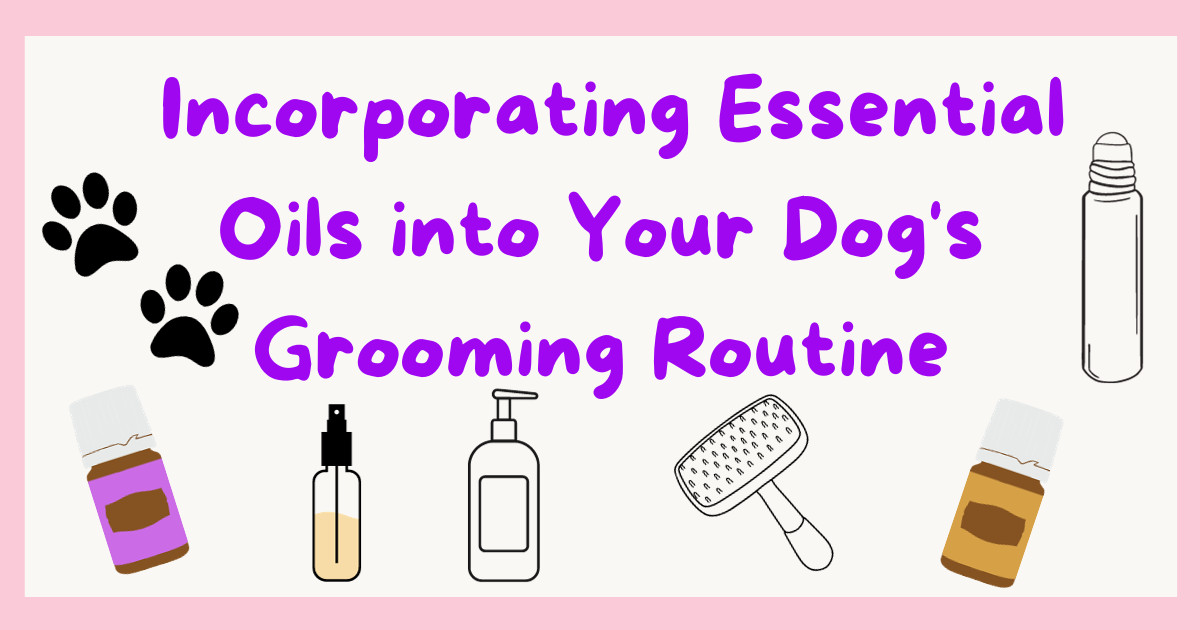
As a devoted dog mom with a passion for horses, I have always sought natural and holistic ways to care for my beloved companions. One of the most significant discoveries in my journey has been the amazing benefits of essential oils for both my dogs and horses. These aromatic wonders can do wonders for their overall well-being and enhance their grooming routine. In this comprehensive guide, I'll share my firsthand experiences and knowledge about incorporating essential oils into your dog's grooming regimen. If you're a fellow dog enthusiast, looking for ways maximize and improve your pets' grooming routine, you'll find valuable insights here.
Understanding the Power of Essential Oils
Before we dive into the practical aspects of incorporating essential oils into your dog's grooming routine, it's essential to understand the science behind them. Essential oils are natural compounds extracted from plants, capturing their aromatic and wellness properties. These oils can positively impact the physical and emotional well-being of our canine friends.
Why use essential oils in grooming:
Grooming may not top our dogs' favorite activities list, but introducing a calming essential oil can foster positive emotions and relaxation. Begin incorporating relaxing essential oils into playtime or cuddle sessions, establishing positive associations for your dog. This way, when used during grooming, the essential oil can not only relax your dog but also evoke those positive feelings from earlier experiences. To embark on your journey of using essential oils with your dog for the first time, visit my 'getting started' blog HERE.
Essential oils have been studied for antimicrobial, antifungal, and anti-inflammatory properties. When used properly, essential oils can help with minor skin irritations, enhance skin and coat health, untangle fur, impart a lustrous shine, and assist in managing unpleasant odors.
The key is to choose high-quality, pure essential oils that are safe for canine use.
Ensuring Safe Use of Essential Oils for Dogs
As a responsible dog mom and horse enthusiast, safety is my top priority. Essential oils are powerful substances, it can take approximately 75 lemons to make a 15ml bottle of lemon essential oil, so it's important to learn how to use them properly. Using them incorrectly can lead to unwanted effects on our beloved companions. Here are some crucial tips for ensuring safe usage:
1. Quality: Quality is paramount when it comes to essential oils. The FDA's limited regulation leaves room for variations in production standards. Some companies introduce additives to standardize fragrance, accommodating differences in aromas and constituents arising from various harvests. Additionally, additives may be used to extend the essential oil, enabling cheaper sales. The process of creating essential oils involves both art and science, encompassing optimal plant growth conditions, timely harvesting, and precise distillation techniques in terms of temperature and duration.
Many essential oils are traded through third parties, often lacking insights into operational and distillation processes. To ensure top-notch quality, it is crucial to procure essential oils from a trusted supplier. Look for a supplier with transparent practices, an open-door policy regarding the sourcing of essential oils, and detailed information on plant cultivation, harvesting, and distillation methods. This can help make sure that you are investing in high-quality, pure, and premium essential oils.
2. Dilution: In general, essential oils should be diluted before applying them to your pets' skin or coat. For dogs, a general rule of thumb is to use a 1% to 2% dilution ratio, meaning one drop of essential oil per one teaspoon of carrier oil, such as coconut oil or olive oil. You can grab my handy dilution chart HERE!
2. Avoid Contact with Eyes, Mucous Membranes, and Sensitive Areas: Exercise caution when applying essential oils to your dog, avoiding sensitive areas to prevent discomfort. I typically refrain from application around the head, unless the essential oil serves a specific purpose in that region. Dogs possess a significantly heightened sense of smell compared to humans, and applying oils around the face and eyes can be overwhelming for them.
3. Start Low and Go Slow: Embrace the "Start Low and Go Slow" approach, a mantra I cherish for using essential oils with animals! Begin by presenting the essential oil bottle to your dog and observe their response—whether it's avoidance, indifference, or a positive interest. Respect their incredible sense of smell; there's no need to remove the lid. Identify an essential oil that resonates with your dog, and consider wearing it as a perfume initially to acclimate them. Avoid pressuring your dog; we aim for a positive experience in introducing essential oils to them.
4. Consult with an Integrative Veterinarian trained in the use of essential oils: If you're new to using essential oils for your pets or have concerns about specific oils, it's always a good idea to consult with a veterinarian experienced in holistic care and essential oils.
Must-Have Essential Oils for Your Dog's Grooming Routine
Now that we've covered the basics of essential oil safety, let's explore some must-have essential oils to incorporate into your dog's grooming routine:
1. Lavender Oil: Known for its calming properties, lavender oil can help reduce tension and stress in dogs. It also has skin-soothing benefits, making it an excellent addition to bath time. It's one of my go to essential oils for hair, skin, and coat support. For more info on using lavender essential oil, click HERE!
2. Roman Chamomile Oil: This gentle essential oil is ideal for dogs with sensitive skin. Roman chamomile can help soothe minor skin irritations and promote a healthy, shiny coat. For more info on using Roman chamomile essential oil, click HERE!
3. Peppermint Oil: With its refreshing scent, peppermint oil can be used for a variety of purposes: combatting odors, cooling- especially during hot summer months, muscle and joint discomfort, digestive system support, and even clarity and focus! For more info on using peppermint essential oil, click HERE!
4. Ravintsara Oil: Ravintsara oil can be beneficial for dogs that may need respiratory system support. It also works well for odor control and has a crisp eucalyptus like aroma with a touch of sweetness.
5. Frankincense Oil: My number one go to for general wellness, frankincense oil can be helpful in promoting overall health. It also has a calming and grounding aroma perfect for grooming sessions. For more info on using frankincense essential oil, click HERE!
6. Cedarwood Oil: This woody-scented oil acts as a natural pest repellent, keeping unwanted guests at bay during outdoor activities. Cedarwood is also known to be helpful for hair and skin and adds a nice shine to the coat. For more info on using cedarwood essential oil, click HERE!
7. Copaiba Oil: One of my favorite essential oils that I like to use with my dogs, copaiba is known for helping to maintain healthy skin. Copaiba oil has also been studied for antimicrobial activity and may contain antioxidant qualities. Antioxidants can help protect skin from free radical damage caused by environmental pollutants like smoke or dust particles. For more info on using copaiba essential oil, click HERE!
Incorporating Essential Oils into Your Dog's Grooming Routine
Now that we have an understanding of essential oils and which ones to use, let's explore practical ways to incorporate them into your dog's grooming routine:
1. Aromatherapy Massage: Dilute a few drops of your chosen essential oil into a carrier oil and give your dog a calming massage. This can help relax their muscles and create a bond between you and your furry friend. This will also spread the essential oils throughout your dogs coat, adding a healthy sheen.
2. Bath Time Bliss: Enhance bath time by adding a drop of lavender or Roman chamomile essential oil to your natural shampoo. This will not only add a delightful and relaxing aroma, but can support your dogs coat as well. For help with outdoor annoyances, add cedarwood as well.
3. DIY Grooming Spray: Craft a natural grooming spray by blending equal parts water and aloe vera gel with 10-20 drops of essential oil. This simple concoction serves to maintain your dog's coat freshness and odor-free between baths. For a step by step guide to making a spray, click HERE.
4. Paw Balm: Make a nourishing paw balm by mixing coconut oil, shea butter, and frankincense or lavender essential oil. Apply this balm to your dog's paws to keep them soft and moisturized. For a step by step guide to making your own paw balm, click HERE.
5. Make a Roller Bottle: Grab a 10 ml roller bottle from Amazon, incorporate 10 drops of your chosen essential oil, and top it off with a carrier oil. Craft a soothing muscle and joint rub by combining peppermint and copaiba, or create a skin support roller with the calming blend of lavender and frankincense. For a step by step guide to making a roller bottle, click HERE.
6. Make a Dry Shampoo: Bath time isn't always ideal, especially in winter. Keep your dogs coat fresh and smelling good by using a DIY dry shampoo in between baths. All you need is baking soda, cornstarch, and essential oils! Click HERE for a step by step guide to make your own.
As a devoted dog mom and horse enthusiast, incorporating essential oils into my pets' grooming routine has been a game-changer. From promoting relaxation and reducing tension to maintaining healthy coats, these natural wonders have brought joy and wellness to my furry companions.
Remember, always prioritize safety and choose high quality, pure, and premium essential oils. If you're new to essential oils, grab my free guide to get you started HERE.
Curious where I get my essential oils?
For those interested in the origins of my essential oils, I invite you to embark on the journey with Young Living™. They uphold an unwavering dedication to quality, sustainability, and purity, evident in their Seed To Seal™ process. This unique approach guarantees the highest standards of purity, potency, and sustainability. As a pet parent, ensuring the quality of products for your furry companions is paramount. I personally have visited multiple Young Living™ farms, actively participating in the harvest and planting processes, reinforcing my confidence in the integrity of their products.
Simplifying your experience, I've curated a special bundle featuring the essential oils highlighted in this blog, accompanied by one of my preferred carrier oils. This comprehensive bundle equips you with all the essentials to seamlessly integrate essential oils into your dog's routine and enhance your grooming rituals! Click HERE.
(This is an affiliate link, and I earn a small commission from your order at no extra cost to you. Thank you for supporting my small business! I'm thrilled to assist you in getting started and will connect with you after your order to send something special your way!)
Embrace the power of essential oils and embark on a holistic journey to enhance your pets' well-being naturally. Happy grooming!
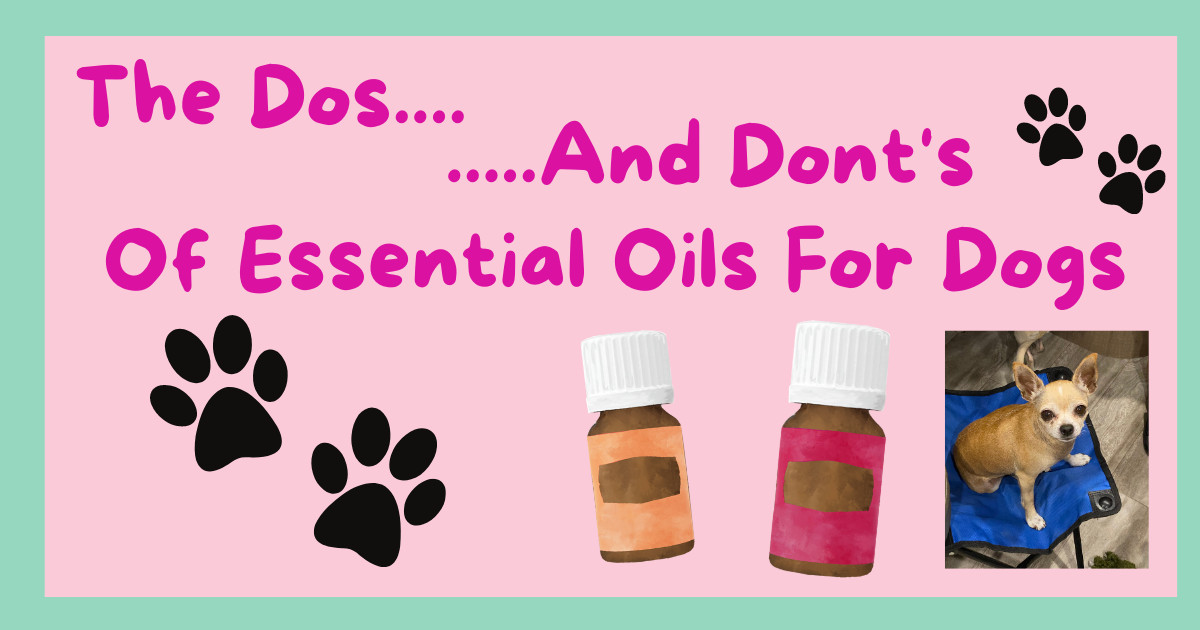
As pet owners, we constantly seek ways to enhance the well-being of our furry companions. Essential oils have garnered attention for their wellness properties and natural benefits, not only for us but also for our dogs. However, before delving into the world of aromatherapy for our canine friends, it's crucial to understand the dos and don'ts of using essential oils for dogs. While these oils can offer various advantages, improper use may pose risks to our pets. In this blog post, we will explore the essential guidelines for safely using essential oils with dogs, ensuring that their health and happiness remain a top priority. By gaining insight into the appropriate usage and pet-safe oils, we can create a harmonious and beneficial aromatic environment for our beloved four-legged companions.
1. The Dos of Using Essential Oils for Dogs
When used correctly, essential oils can provide various wellness benefits for dogs. Here are some essential dos to keep in mind:
a) Consult A Holistic Veterinarian Familiar And Trained In Aromatherapy: When it comes to using essential oils for your furry companion, consulting a holistic veterinarian trained and experienced in the art of aromatherapy can make a significant difference. Unlike regular vets who might dismiss essential oils without understanding their potential benefits, a holistic veterinarian possesses specialized knowledge of natural therapies and their applications in pet care. These experts understand the intricacies of essential oils, including their chemical properties, appropriate dilution ratios, and suitable oils for specific conditions. By seeking guidance from a holistic veterinarian, you can ensure a tailored and safe approach to using essential oils for your pet's well-being, making informed decisions that promote their health and happiness. Their expertise allows you to explore the world of aromatherapy for your pet with confidence and peace of mind.
b) Choose High-Quality Pure Essential Oils: Quality matters when it comes to essential oils. Opt for pure, premium essential oils that are free from additives or synthetic ingredients. Low-quality oils may contain harmful substances that can be toxic to dogs.
c) Proper Dilution: Essential oils boast incredible concentration; for instance, it takes approximately 27 square feet of lavender plant to produce a mere 15 ml bottle of lavender essential oil. Due to this potent concentration, diluting essential oils offers numerous benefits. Firstly, it allows us to use the smallest amount necessary to achieve the desired effect. Additionally, diluted oils can be applied over larger surface areas, reducing the risk of skin reactions. Moreover, the dilution process enables the essential oil to stay on the skin for a longer duration, countering the rapid evaporation typical of highly volatile oils. By slowing down the absorption rate, we facilitate the body's safe and efficient processing of the essential oil. Embracing proper dilution practices ensures a harmonious and secure experience when utilizing essential oils for our fur kids well-being.
d) Start Slowly and Observe: When introducing essential oils to your dog, start with low concentrations aromatically and observe their response. Some dogs may be more sensitive than others, so it's essential to monitor for any signs of discomfort or adverse reactions. For more tips on getting started using essential oils aromatically with your dog, click HERE.
e) Monitor Behavioral Changes: Keep an eye on your dog's behavior after using essential oils. If you notice any abnormal signs, such as excessive drooling, lethargy, stupor, or even vomiting, discontinue use immediately and remove your dog from the area.
f) Use Pet-Safe Oils: Read your labels and avoid buying products where the label advises against use with pets. Not all essential oils are created equally. A pure and premium essential oil, properly diluted, can be safe for dogs. Get to know your essential oil company and if they can't answer yes to the following questions, they may not have a pure product:
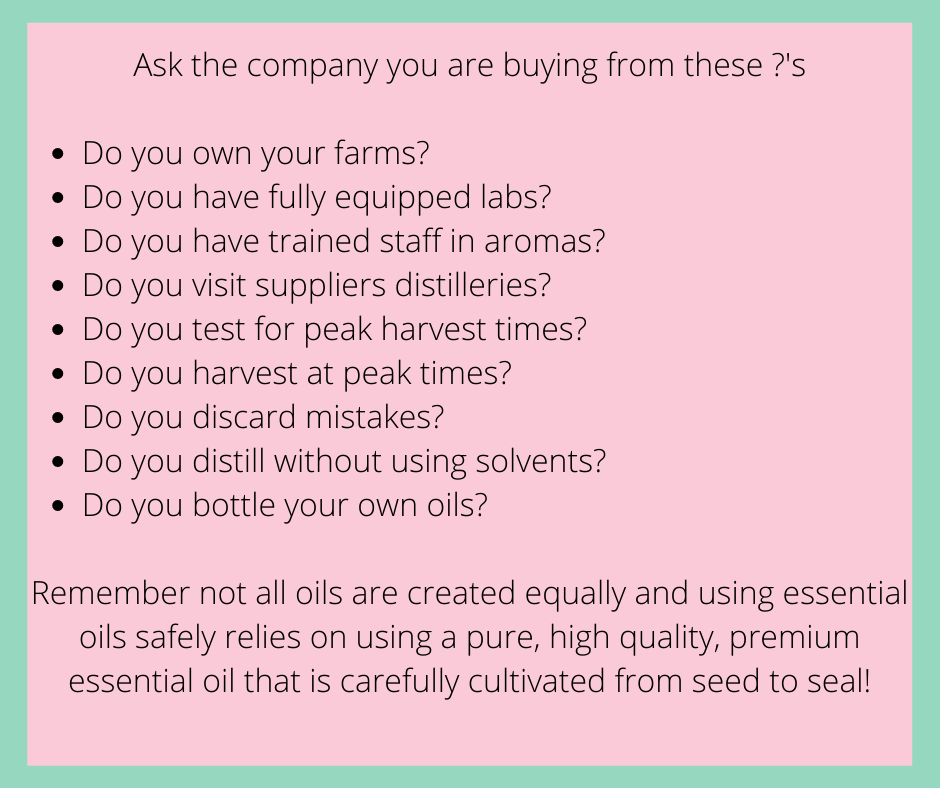 When you are just getting started, stick to well regarded pet-safe oils like lavender, copaiba, or frankincense, which are generally well-tolerated by dogs.
When you are just getting started, stick to well regarded pet-safe oils like lavender, copaiba, or frankincense, which are generally well-tolerated by dogs.2. The Don'ts of Using Essential Oils for Dogs
While essential oils can be beneficial for dogs, there are several important don'ts to be aware of:
a) Don't Force essential oils on your dog: Start low and go slow! Offer the essential oil bottle to your dog and see how they react. Dogs have a much greater sense of smell than we do and they are getting a whiff even with the lid on!
b) Don't Apply Undiluted Oils: Undiluted essential oils can be too much for your dog. It's generally best to always dilute essential oils properly before applying them to your dog's skin or fur.
c) Don't Overdo It: Moderation is key when using essential oils for dogs.Essential oils work better with a small amount more frequently. Allow your dog an 'out'. Let them choose to leave the aroma if they'd like.
d) Avoid Sensitive Areas: Dogs have more sensitive noses than humans, so generally it's best to avoid applying essential oils around their head unless you are using them for something specific. Also, avoid applying directly to their eyes, nose, mucous membranes, or genitals.
e) Don't buy essential oils from a company you haven't researched and know, like, and trust: Not all essential oils are created equally. Unfortunately many essential oils on the market today are adulterated. There is little regulation in the industry and other factors such as the actual growing of the plant, harvesting, and distillation all contribute to whether a pure essential oil comes out the other side. Be sure to research where and whom you are buying your essential oils from.
Essential oils can offer a wealth of benefits to us and our fur kids when used properly. Remember to consult your holistic veterinarian, choose pet-safe oils, dilute properly, and closely observe your dog's response. By following the dos and don'ts outlined in this blog post, you and your dog can enjoy all the benefits that essential oils bring to the table.
Wondering where I get my 100% pure and premium essential oils? Click HERE to explore Young Living™ Essential Oils. With Young Living, you can experience the benefits of high-quality essential oils and infused products backed by their Seed to Seal® promise, ensuring purity, potency, and sustainability. Start your aromatic adventure today and discover the world of pure, premium, and authentic essential oils from Young Living. Click HERE to learn more! (This is an affiliate link and I earn a small commission from your order at no cost to you. Thanks for supporting my small business! I'm so excited to help you get started, that I'll connect with you once you order and send you something special!)
